Visitors to an Automobile Museum planned for Nanjing will drive their cars into the building and up an undulating, uneven ramp to the roof. As designed by 3Gatti.com Architecture Studio, which has offices in Shanghai and Rome, the 15,000-square-meter museum will offer a drive-through experience, as well as exhibitions, restaurants, shops, a special events space, an automobile sales office, a design center, and laboratories to be visited on foot.

“We designed a building geared to the automobile, where the car is the point of reference,” says Francesco Gatti, the principal of 3Gatti. Gatti’s design is “dedicated to the car as an object of desire, a world to explore, a technology to study and an article to display,” explains the architect. He imagines “a dynamic building with surfaces that are continuous and fluid, without interruptions,” so it recalls the sensation of moving along a road, explains Gatti.
3Gatti won a competition for the project, organized last year by the government of Nanjing and Jiangsu Head Investment Group. The clients hope to use the museum to draw attention to Nanjing’s role as an important automobile center and help convert an industrial suburb of the city into a new technology district.
Gatti envisions the building as a pair of spirals—an outer one for cars to drive up and an inner one for people to walk down. A glass partition will separate the two realms. As visitors drive up the outer spiral, they will see cars exhibited on angled ramps and planes. “We designed undulating, uneven surfaces,” says Gatti, “so people see the cars from different perspectives, from above and below.” After parking their cars on the roof, visitors walk down ramps to explore exhibition areas and other public spaces. When they are finished, they can take an elevator back to the roof and their cars.
The building’s structural system will use a series of radial beams that change size as they spiral up to the roof. At first, the clients asked Gatti to design a steel structure so the building could be constructed quickly. But as the world economy has experienced trouble in recent months, the project’s schedule has slowed down and may allow the architect to use a concrete structure.




Post a comment to this article
Report Abusive Comment